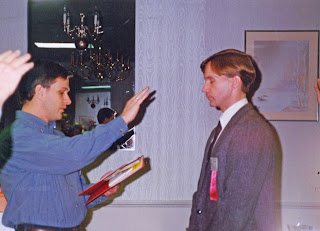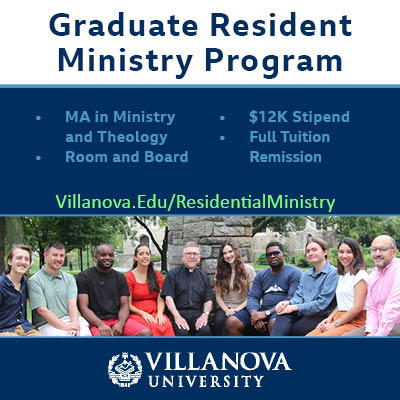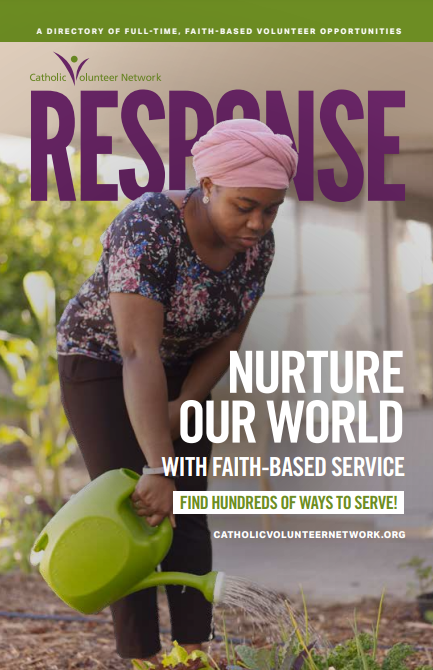Early Beginnings
It started with a crayon and a blank piece of paper. Ten year old Jimmy began to draw a picture of a priest next to a thatched roof hut in Africa, indicating what he was going to be when he grew up.
“The only thing I ever really truly wanted to be when I was a boy was a priest,” Lindsay remembered.
Years later, in the August of ’76, the Eucharistic Congress in Philadelphia must have seemed like Lindsay’s version of heaven. The civic center was filled with row after row of what seemed like every Catholic organization on the continent. The plastic bag in his teenage hand got heavier and heavier with each vocations brochure he picked up. But one stuck out— that of the Friars of the Atonement. It sat on the top drawer of his desk for two years before Lindsay made the call. After a discernment weekend with the friars, the Psychology major at LaSalle University decided he would join them after graduation. He liked that they were Franciscan, that they were founded in the States and that their charism focused on ecumenism and Christian unity—a charism he still finds important today.
“I pretty much just fell in love with them,” Lindsay recalled, leaning forward in his office chair. “I felt very drawn to the pastoral work.”
But there were still many unanswered life questions. Lindsay had never had a full-time job, for example, or lived on his own. So after postulancy, novitiate and renewal of first vows, and after six and a half years discerning his priesthood dream, Lindsay left the Friars of the Atonement with every intention of exploring the world and then coming back.
In the six years with the friars, Lindsay got a Masters of Divinity from The Catholic University of America, worked as a hospital chaplain, did parish work, helped out at a youth summer camp and had weekly apostolates working with the young adult ministry office of the Archdiocese of Washington, St. Elizabeth’s hospital with patients of mental illness, and Sarah’s House for homeless women. These experiences were like a rich-soil that allowed Lindsay to have a deep-rooted understanding of service and its role in his faith by the time he began overseeing daily operations at Christ House.

Christ House was and is a 24-hour residential medical facility for homeless men and women, though it was only for men at the time Lindsay joined the team. His position there was his first full-time job. 3am calls to rescue patients stuck in elevators were exchanged for morning prayer, talking to patients and helping in the kitchen became Lindsay’s pastoral care, mopping up a spill replaced daily mass. The staff of about 45 and the six or so volunteers that Lindsay shared a house with became a new type of friary—one he would devote himself to for the next nine years.
“I really saw [my work] as a ministry — as a continuation of my seminary experience,” Lindsay explained.
After a couple years, Lindsay helped start the formal Christ House volunteer program. In the summer of ‘89, the staff bought a house in Adams Morgan that he spent the next three months furnishing. Lindsay inadvertently lost 10 pounds putting up brochures, checking bulletins, collecting second-hand furniture and driving all over the district to fill the four story house.
“We didn’t buy one thing,” Lindsay chuckled.
They called it Emmanuel House—a place where inhabitants could hope to feel the presence of God. The volunteers lived upstairs while Lindsay inhabited his own basement apartment. Cooking with young adults several nights a week was probably a breeze compared to the 20 roommates he had back in the friary. Yet there was always something going on.
“It really felt […] like a ministry to me because we worked with homeless people that had medical needs. A lot were mentally ill, a lot had drug and alcohol addictions,” Lindsay said. “You couldn’t help but get involved in some of the pastoral work.”
Christ House was where Lindsay first heard about Catholic Volunteer Network (CVN). The medical facility advertised their volunteer program in the network’s annual RESPONSE directory of faith-based service programs. In ‘96, Lindsay got a call from a CVN board member asking if he knew of anyone who would be a good candidate as their Executive Director.
 “Well actually now that you mention it,” he remembers saying without hesitation. But if the board member had not happened to call him that day, Lindsay probably would never have taken the initiative to apply.
“Well actually now that you mention it,” he remembers saying without hesitation. But if the board member had not happened to call him that day, Lindsay probably would never have taken the initiative to apply. Several interviews, individual meetings and a recorded question and answer session later, Lindsay stood before the Catholic Volunteer Network Board as the Executive Director.
As the new Executive Director, Lindsay was in charge of a budget, was more frequently traveling, maintained and promoted CVN’s mission and oversaw the staff. This was the first time he did not live in community and had no one but the board to answer to. It took about six months, at the organization’s annual conference, for Lindsay to really begin to get the hang of his new position.
“The shock of leaving Christ House and coming [to CVN] was so much more dramatic than when I left the seminary,” Lindsay explained.
He succeeded Sister Ellen Cavanaugh, who had served as Executive Director of the network for eight years. The Sister of Mercy had stabilized the network, which was on the verge of bankruptcy, when she arrived in 1986. Her dynamism brought the attention of the Church hierarchy to the role of lay volunteers, and her passion for the mission helped strengthen the foundation of the organization. In March of 1992, she and two others met with Pope John Paul II in Rome, where he told them to “continue, continue, continue” the work. Two years later, Sister Cavanaugh received the annual CVN Mader Award, honoring her contributions to faith-based service.
 “The reason why the office has survived and the work has grown [..] is because of directors like Ellen and Jim,” said Patricia Mader Stalker, co-founder of CVN. “It seems as though with each passing year, the directors that have taken charge have fitted in with the times.”
“The reason why the office has survived and the work has grown [..] is because of directors like Ellen and Jim,” said Patricia Mader Stalker, co-founder of CVN. “It seems as though with each passing year, the directors that have taken charge have fitted in with the times.”Lindsay’s was the time of the digital revolution. With internet use flourishing, the new executive director wanted to make sure CVN went online as quickly as possible. He also came at a critical time in the Church when the laity were reaching out more and more as active volunteers—a role traditionally “reserved” for priests and religious.
“Very quietly but strongly, I watched CVN grow, stabilize,” said Sister Cavanaugh, now in her 80s. “I could see from my very first involvement with Jim that he understood what the Network could do and would do.”
In 1998, the organization’s first website went live. Later that year, CVN received a grant from the Corporation for National and Community Service to administer AmeriCorps Education Awards. By 2000, 200 programs were part of the CVN coalition. By 2001, 20 percent of CVN members represented other Christian traditions. Three years later, a record number of 10,379 volunteers served with their member programs.
“I’ve always thought of us as a kind of bridge that helps people find each other—helps programs and people find each other,” Lindsay said.
Catholic Volunteer Network –The beginning
The bridge began to be built in the late ‘50s when Patricia Mader Stalker said she wanted to “do more” as a lay person. People would look at her with raised eyebrows. Shouldn’t she be thinking about getting married? Did this mean she wanted to join religious life? It was Mader’s family that offered her support. Her older brother, Fr. George Mader, helped her find the Mission Helpers of the Sacred Heart volunteer program in North Carolina. Little did the siblings know how much Pat’s year of volunteer work would change their lives.
“George was always very innovative. He started different programs himself early on in his priesthood with people in the parishes that he was in,” Mader Stalker recalled. “He was always looking for new ways to help other people out and he came down to visit me in North Carolina a couple of times.”
On a trip to visit his sister in a segregated tobacco community in North Carolina, Fr. Mader realized the relative anonymity of Pat and the other female volunteers. No one really knew about their work, not even the Archdiocese. Seeing a need for more effective communication, Fr. Mader and his sister decided to start an organization that would connect lay people looking to do volunteer work with service programs. In doing so, they planted the seed of Catholic Volunteer Network.
“God wanted his people to be involved with helping other people. It’s as simple as that. There’s nothing really complicated about it,” Mader Stalker said, reflecting on CVN’s origins.
Celebrating Fifty Years
Fifty years after the Mader siblings excitedly began their plans in the Archdiocese of Newark, Lindsay sits down at his dining room table, his dogs at his feet, and opens the draft. His right hand holds his favorite blue pen as his well-trained eyes scan each of the over 200 program descriptions. 136 pages and countless hours later, he has proofread the entire RESPONSE directory, cover to cover. This is Lindsay’s favorite part of his job. Going program by program, state by state, age by age, ministry by ministry, Lindsay is reminded of the breadth and depth of the Network.
“When you sit and you read every detail of every service opportunity, every geographical location, the age groups, all the different types of placements that are possible, the length of service, it’s just overwhelming. And that’s when I feel like we’re doing something that’s just incredible,” Lindsay said.
Today, Catholic Volunteer Network celebrates fifty years as a leading non-profit association for domestic and international faith-based volunteer programs. Currently, more than 18,000 volunteers serve in its member programs throughout the U.S. and in over 100 other countries worldwide. Through a partnership with the Corporation for National and Community Service, Catholic Volunteer Network supports over 1,000 AmeriCorps members annually.
“I’ve been able to live out these last 26 years really doing ministry, every day coming to a job that was about making the world a better place and helping people,” Lindsay said, his hazel eyes shining through his glasses. “I can’t really ask for more than that.”
 “Well actually now that you mention it,” he remembers saying without hesitation. But if the board member had not happened to call him that day, Lindsay probably would never have taken the initiative to apply.
“Well actually now that you mention it,” he remembers saying without hesitation. But if the board member had not happened to call him that day, Lindsay probably would never have taken the initiative to apply.  “The reason why the office has survived and the work has grown [..] is because of directors like Ellen and Jim,” said Patricia Mader Stalker, co-founder of CVN. “It seems as though with each passing year, the directors that have taken charge have fitted in with the times.”
“The reason why the office has survived and the work has grown [..] is because of directors like Ellen and Jim,” said Patricia Mader Stalker, co-founder of CVN. “It seems as though with each passing year, the directors that have taken charge have fitted in with the times.”





 Thousands of faith-based service opportunities can be at your fingertips with the RESPONSE. Download the latest edition today!
Thousands of faith-based service opportunities can be at your fingertips with the RESPONSE. Download the latest edition today!
